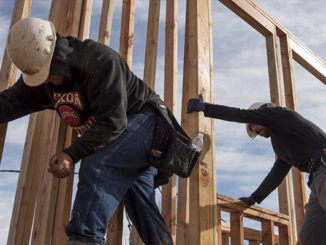
by Dan Frosch, WSJ
New Mexico measure barring federal government from acquiring state land is among the potential hurdles
There are scant signs of civilization along the 22 miles of rugged New Mexico state land that skirt its southern border. But for opponents of President Donald Trump’s plans to build a wall between the U.S. and Mexico, this remote stretch of desert represents one of several flashpoints across the Southwest in their efforts to try to stop him.
Democratic state lawmakers in New Mexico have proposed legislation that would bar the federal government from acquiring the land to build a border wall. The legislation, which cleared a second committee on Tuesday, is one of several legal efforts being weighed by opponents of the wall in border states.
The Department of Homeland Security in 2006 was granted legal latitude to fence off some borderlands, and the federal government has broad powers to seize land through eminent domain. But the New Mexico legislation signals a range of challenges for the project.
In New Mexico, whose border with Mexico stretches over 150 miles, the proposal was prompted by Democratic fears that the wall will hurt its expanding trade relationship with Mexico. According to U.S. Census data, New Mexico exported roughly $1.5 billion of goods to Mexico last year, more than three times the value of its Mexican exports in 2010.
“The wall is a divisive political ploy that will not address the issue of illegal immigration or the criminal drug trade,” said State Rep. Javier Martinez, one of the bill’s sponsors. “But what it will do is severely impact our economic relationship with Mexico.”
The bulk of the nearly 2,000-mile U.S. border with Mexico lies along Texas, where the administration is likely to encounter the most difficult obstacles to building a barrier—from the Rio Grande to objections from some within Mr. Trump’s own party. But potential hurdles are arising in other border states, too.
In California, Gavin Newsom, the state’s Democratic lieutenant governor, has raised the prospect of legal and logistical challenges to the wall, possibly using state and federal environmental laws to stymie construction. Roughly 100 miles of California’s border are already lined with some type of fencing. But 40 miles have no barrier. A spokesman for Mr. Newsom said he has instructed the State Lands Commission to look into how California-owned land would be affected by the wall.
In Arizona, the Tohono O’odham Nation, an Indian tribe that has 75 miles of its reservation along the border, has come out against the wall. The tribe said it would adversely affect its traditional land, some of which extends into Mexico, and would be logistically difficult to build in certain areas because of the terrain. The tribe noted it has worked closely with the U.S. Customs and Border Patrol and other federal agencies to help secure the border through vehicle barriers and other measures.
“The Nation, and federal agencies and departments, are securing the West desert. We are actually doing something right,” said tribal Vice Chairman Verlon Jose. “Maybe we can use the billions of dollars being proposed for the wall and use them for more technology, more agents and better access roads.”
 Officials with the Trump administration didn’t immediately respond to a request for comment about the tribe’s worries over the wall.
Officials with the Trump administration didn’t immediately respond to a request for comment about the tribe’s worries over the wall.
Sean Hecht, an environmental law professor at UCLA’s law school, said it is yet unclear whether states or Indian tribes can do much to stop the wall. A series of congressional actions, including the Secure Fence Act of 2006, gave the federal government broad powers to construct at least 700 miles of border fence wherever it saw fit. About 654 miles of fencing have been built so far.
Congress also allowed the Homeland Security Department to waive local, state and federal regulations that would have subjected it to potentially lengthy environmental reviews as it built the border fencing.
Legal experts said it is uncertain whether the same principles apply to a full-fledged wall running the length of the U.S. border with Mexico, which Mr. Trump has ordered.
“We don’t know what the precedent is for a wall,” Mr. Hecht said.
Michael Chertoff, who served as Homeland Security Secretary under George W. Bush, said he used the waivers judiciously when constructing the existing fencing, and sought to collaborate with local border communities.
“We tried to be solicitous of environmental concerns and as local concerns as we laid things out,” he said.
A November report from the Congressional Research Service noted there was nothing in current federal law that appeared to bar Homeland Security from expanding construction beyond the existing border fencing as long as it was done “to deter illegal crossings in areas of high illegal entry.”
Ilya Somin, a law professor at George Mason University who has written critically of the proposed border wall, said the New Mexico measure, if it passes, could stall the Trump administration’s plan but not stop it.
Generally, Congress must authorize the use of eminent domain, Mr. Somin said. The federal government has to provide fair value for the land it takes, or condemns. Fights over compensation or procedural challenges could slow the wall’s construction, he said, but no property owner in modern times has successfully petitioned a court to stop the federal government from taking land for public use.
Even the New Mexico lawmakers behind the proposal there acknowledge the measure couldn’t supersede federal use of eminent domain, only draw out the process.
Some Republican border-state lawmakers have indicated they’re willing to work with the president on the land-use issues.
Aubrey Dunn, New Mexico’s land commissioner, a Republican, recently wrote Mr. Trump offering to swap at least 32,200 acres of state trust land along the border with more desirable federal land in New Mexico. Kristen Haase, an assistant land commissioner, said if the Trump administration didn’t take the deal, it would have to pay New Mexico a $3 million one-time easement fee to access the land.
The Trump administration didn’t immediately respond to a request for comment on the proposal.



